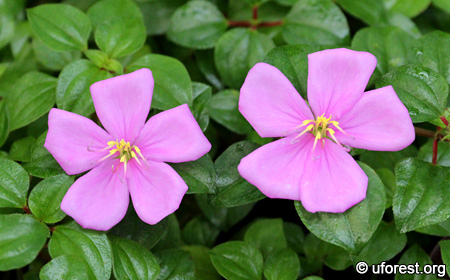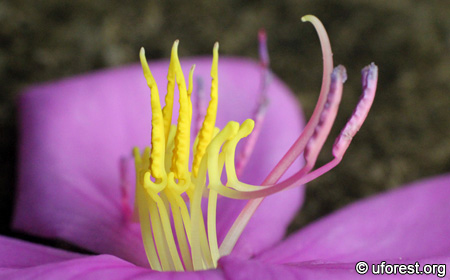Heterotis rotundifolia (Sm.) Jacq.-Fél
| Etymology | Genus | Other ear, probably referring to the lobing filaments |
|---|---|---|
| Species | Having round leaves | |
| Family | Melastomataceae | |
| Synonyms | Dissotis rotundifolia (Sm.) Triana | |
| Common Names | Pink Lady, Dissotis | |
| Status | Exotic: Cultivated Only | |
| Form | Creeping herb | |
| Native Distribution | Tropical Africa | |
Diagnostics:
This plant flowers continuously, and the pink flowers bear a marked resemblance to those of the native shrub, Melastoma malabathricum. However, the small rounded leaves and its creeping habit is more than enough to differentiate between the two. The Pink Lady is commonly growth as a ground cover in Singapore.
Interesting Facts:
The flowers bloom before the first light of the day and closes in the middle of the next day (Ng, 2010). The stamens have two distinct forms . The first is short and ends with yellow anthers. The second extends outwards in yellow and then lobbed outwards in purple-pink ending in a similarly purple pink anthers. This floral structure is common in the family Melastomataceae.While yet to escape from cultivation in Singapore, Heterotis rotundifolia is considered a high risk weed by PIER (2006). It has already turned invasive in a number of the Pacific islands and is a dominant weed in Australia. They can be spread by either seeds or cuttings.
The Pink Lady is used as a traditional medicine in its native country many ailments like rheumatism and diarrhea (Watt & Breyer-Brandwijk, 1962). This is partially substantiated by clincial tests demonstrating anti-microbial activity using extracts of the plant (Abere, 2010).

Carpet of Heterotis rotundifolia spread over the ground in the Singapore Botanic Gardens.

Leaves are opposite and tri-veined

Attractive pink flowers.

There are two types of stamens, one with yellow and other with purple anthers.

The caylx and ovary are covered with radiating bristles.
References
Abere TA, PE Okoto, FO Agoreyo. (2010) Antidiarrhoea and toxicological evaluation of the leaf extract of Dissotis rotundifolia triana (Melastomataceae). BMC Complementary & Alternative Medicine, 10: 71.
Ng FSP. (2010) Tropical Horticulture & Gardening. MPH Group Publishing, Malaysia. 361 pp.
PIER (2006) Dissotis rotundifolia. Pacific Island Ecosystem at Risk (PIER), Institute of Pacific Islands Forestry. http://www.hear.org/pier. Accessed on 17-Dec-2012.
Watt JM, Breyer-Brandwijk MG. (1962)The Medicinal and Poisonous Plants of Southern and Eastern Africa. 2nd Edition. E & S Livingstone Ltd, Edinburgh and London, 1457 pp.
Author: Siyang
Posted: 2012-12-18 / Modified: 2025-09-23